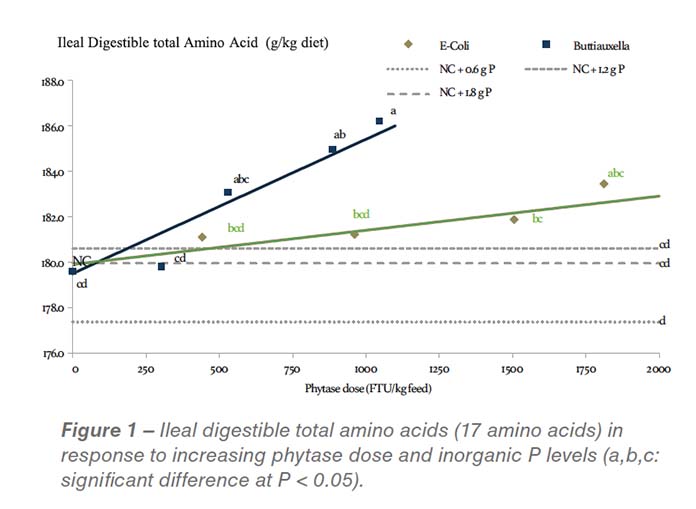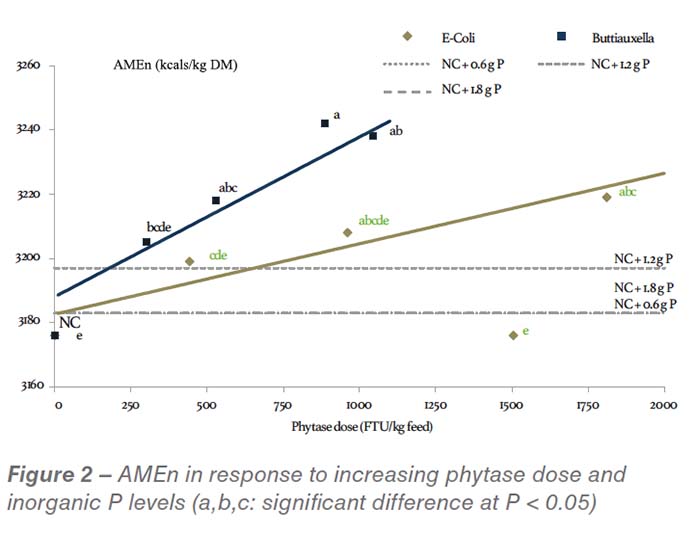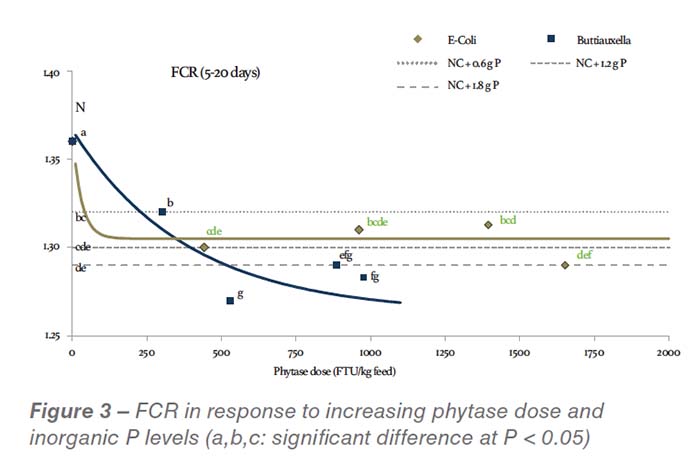
Commercial broiler feed is formulated mainly with plant based ingredients including cereals and oil seeds. These ingredients provide low available P because 70-80% of P is in the form of phytate, which is poorly utilized by mono-gastric animals. In addition, it is well known that phytate can bind to proteins mainly at the stomach pH and bind to minerals mainly at the intestinal pH and therefore reduce the availability of other nutrients such as amino acids.
Phytase has been traditionally used at 500 FTU/kg with the primary objective of improving phytate P digestibility and therefore reduce the excretion of P to the environment. Recent studies demonstrated that phytate degradation rate was positively co-related to amino acids digestibility.
 This study tested the effect of increasing phytase dose on ileal AA digestibility, AMEn and performance in Ross 308 male broiler fed corn/soybean meal based test diets from 5-21 days of age. A negative control broiler feed diet (NC) was formulated without inorganic P, and supplemented with four different dose levels of phytase, with either a Buttiauxella sp phytase up to 1050 FTU/kg feed or an E. coli phytase up to 1810 FTU/kg feed. Three PC diets with addition of 0.6, 1.2 and 1.8 g P from MCP/kg feed to NC were used as reference. Increasing phytase dose showed a linear increase in ileal dig AA and AMEn, a greater efficacy of Buttiauxella phytase was found compared to E. coli phytase based on the slope ratio. Buttiauxella sp phytase at 1050 FTU/kg increased ileal AA digestibility, AMEn and reduced FCR (P<0.05) compared to the PC with 1.8 g/kg P from MCP and revealed an extra-phosphoric effect. The objective of this study was to determine ileal AA digestibility and AMEn in response to increasing phytase dose in broiler feed. Performance and tibia ash were also measured.
This study tested the effect of increasing phytase dose on ileal AA digestibility, AMEn and performance in Ross 308 male broiler fed corn/soybean meal based test diets from 5-21 days of age. A negative control broiler feed diet (NC) was formulated without inorganic P, and supplemented with four different dose levels of phytase, with either a Buttiauxella sp phytase up to 1050 FTU/kg feed or an E. coli phytase up to 1810 FTU/kg feed. Three PC diets with addition of 0.6, 1.2 and 1.8 g P from MCP/kg feed to NC were used as reference. Increasing phytase dose showed a linear increase in ileal dig AA and AMEn, a greater efficacy of Buttiauxella phytase was found compared to E. coli phytase based on the slope ratio. Buttiauxella sp phytase at 1050 FTU/kg increased ileal AA digestibility, AMEn and reduced FCR (P<0.05) compared to the PC with 1.8 g/kg P from MCP and revealed an extra-phosphoric effect. The objective of this study was to determine ileal AA digestibility and AMEn in response to increasing phytase dose in broiler feed. Performance and tibia ash were also measured.

Materials and methods
The trial comprised in total twelve broiler feed dietary treatments with 6 replicates/ treatment. A negative control (NC) diet was formulated with 2900 kcal/kg AMEn, 21% CP, 0.18% retainable P, 0.25% phytate-P, and 0.65% Ca. The negative control diet was supplemented with 4 graded levels of either a new generation Buttiauxella sp phytase (expressed in Trichoderma reesei, highly active at low pH and wide pH range) or an E coli phytase (expressed in Pichia pastoris) at targeted dose level of 250, 500, 750, 1000 FTU/kg feed.
Three positive control broiler feed diets (PC) were used to determine the response of the broilers to increasing retainable P levels, with addition of MCP to supply 0.6, 1.2 and 1.8 g p per kg feed to NC. Dietary Ca was increased by 0.8 g/kg in the PC diets to maintain a reasonable Ca/P ratio. In order to assure a similar diet composition, apart from Ca, P and phytase, one basal mixture of feed was produced, containing 0.25% titanium dioxide as an inert dietary marker. This batch was divided to 12 sub-batches, and were used for production of the PC diets (adding MCP, diamol and CaCO3) and the test diets (adding phytase and diamol). No coccidiostat or other enzymes were added to the diets. Broiler feed diets were analysed for P and Ca content and the analysed values were very similar to formulated values. The phytase premix samples and dietary samples were analysed by LUFA, Germany (an independent laboratory) to determine the phytase activity. The analysed activity was higher than targeted activity for E coli phytase and therefore the analysed activity was used for both phytase sources being 300, 530, 890 and 1050 FTU for the Buttiauxella phytase and 440, 960, 1500 and 1810 FTU for the E. coli phytase. One-day-old Ross 308 male broilers were housed in a large floor pen during the 5 day pre-experimental period and were fed a pelleted, nutritional adequate broiler starter diet. At 5 days of age 1152 healthy broilers were allocated to 72 two-tier balance cages (16 broilers per cage) based on a weight class system to achieve similar mean BW per cage at the start of the experiment.
The experimental broiler feed diets were pelleted and fed to the birds at ad libitum from 5-21 days of age. Water was freely available during the whole period. Ileal contents were collected at the last day of the experiment. Ileal chyme samples were freeze-dried, ground and analysed for dry matter, Ti and amino acids (excl. Tryptophan). Excreta were collected per cage during three successive days (18, 19 and 20), for N and AMEn measurement. The data were analysed as a randomised block design by analysis of variance (ANOVA) using GenStat® statistical package for Windows (14th edition). A cage was the experimental unit. Treatment means were compared by LSD. P< 0.05 is statistically significant.

Results
Increasing phytase dose resulted in linear increase in AMEn and ileal digestible AA, while ADG, FCR and tibia ash responded in a more curvilinear manner. Ileal total amino acid (sum of 17 AA) content increased linearly with increasing phytase dose, however, the slope was greater with Buttiauxella phytase than E. coli phytase (see Figure 1), indicating a greater efficacy. Increasing inorganic P level from 0.6 to 1.8g/kg form MCP numerically increased ileal digestible total AA, however, Buttiauxella phytase at 1050 FTU/kg significant increased ileal digestible total AA compared to all three PC diets and the E. coli phytase at the similar dose. Similar dose response was seen with AMEn (Figure 2). The digestible AA and AMEn results were corresponding to the significantly lower FCR with Buttiauxella phytase at 1050 FTU/kg, compared to NC, PC and the E. coli phytase at 1500 FTU (Figure 3).
Body weight gain (BWG, data not shown) and tibia ash data (Figure 4) showed that Buttiauxella phytase at 1050 FTU/kg was equivalent to inorganic P added at 1.8g/kg from MCP, while E. coli phytase at 1500 FTU/kg maintained BWG and tibia ash at a level comparable to PC with 1.2g/kg P from MCP.

Discussion
Selle et al. (2012) reviewed that phytate can reduce AA absorption due to the following mechanisms:
- bind to AA, forming binary protein-phytate complexes or ternary protein- phytate complexes at pH levels below or above the isoelectric point of proteins and are refractory to pepsin digestion;
- may increase mucin secretions into the gut and increase endogenous AA losses;
- may interfere with starch and AA absorption by compromising Na(+)-dependent transport systems and the activity of the Na pump.
A phytase that is more active at low pH and wide pH range will break down phytate more quickly and completely in the stomach or gizzard, and reduce these anti-nutritional effects of phytate, result in increased digestibility of AA and AME.
This study showed a clear extra-phosphoric effect with increasing Buttiauxella phytase dose to 1050 FTU/kg, which resulted in an increased digestible AA, AMEn and feed efficiency. A greater efficacy with Buttiauxella phytase was observed compared to the E. coli phytase, which might be explained by the different pH optima of the phytases. Compared to the NC diet, 1050 FTU Buttiauxella phytase increased ileal digestibility of total AA (sum 17 AA) by 5.3 g/kg, whereas the increase was 2.6 g/kg for 1810 FTU E. coli phytase. Based on the linear regression analysis, with corn/SBM based diets used in this study, 1000 FTU Buttiauxella phytase could increase 5.9 g/kg ileal total digestible AA (sum of 17 AA), whereas the increase would be 1.5 g/kg for the E. coli phytase at 1000 FTU.
References
Amerah AM, Plumstead PW, Barnard LP & Kumar A (2014) Poultry Science 93: 906-915.
Liu SY, Cadogan DJ, Peron A, Truong HH & Selle PH (2014) Animal Feed Science and Technology 97: 164-175.
Selle PH, Cowieson AJ, Cowieson NP & Ravindran V (2012) Nutrition Research Review 25: 1-17.
Truong HH, Bold RM, Liu SY & Selle PH (2015) Animal Feed Science and Technology 209: 240-248.
From the Proceedings of the Australian Poultry Science Symposium
















